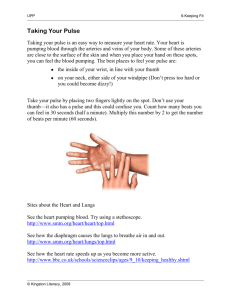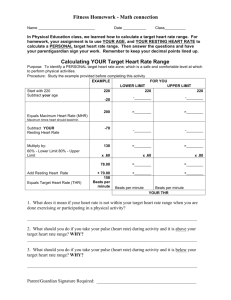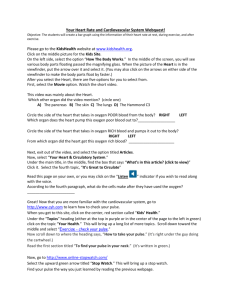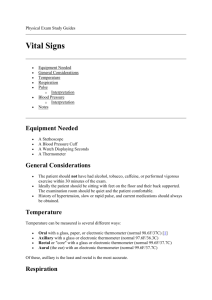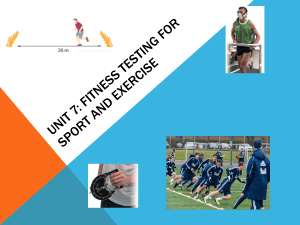AP Biology
advertisement
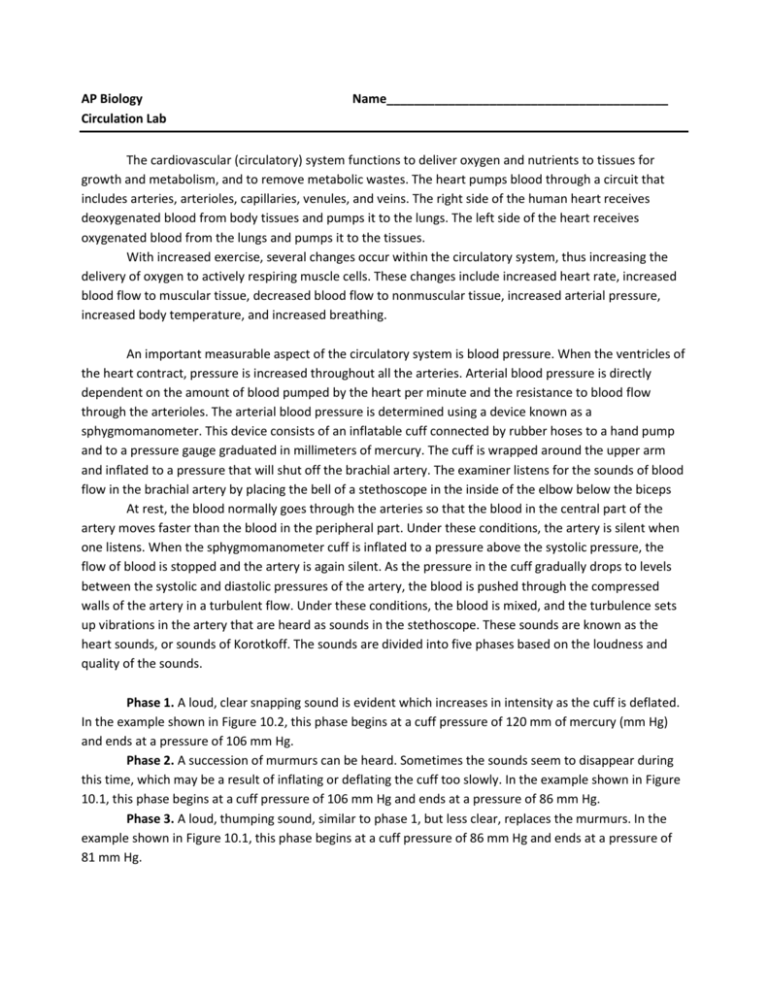
AP Biology Circulation Lab Name_________________________________________ The cardiovascular (circulatory) system functions to deliver oxygen and nutrients to tissues for growth and metabolism, and to remove metabolic wastes. The heart pumps blood through a circuit that includes arteries, arterioles, capillaries, venules, and veins. The right side of the human heart receives deoxygenated blood from body tissues and pumps it to the lungs. The left side of the heart receives oxygenated blood from the lungs and pumps it to the tissues. With increased exercise, several changes occur within the circulatory system, thus increasing the delivery of oxygen to actively respiring muscle cells. These changes include increased heart rate, increased blood flow to muscular tissue, decreased blood flow to nonmuscular tissue, increased arterial pressure, increased body temperature, and increased breathing. An important measurable aspect of the circulatory system is blood pressure. When the ventricles of the heart contract, pressure is increased throughout all the arteries. Arterial blood pressure is directly dependent on the amount of blood pumped by the heart per minute and the resistance to blood flow through the arterioles. The arterial blood pressure is determined using a device known as a sphygmomanometer. This device consists of an inflatable cuff connected by rubber hoses to a hand pump and to a pressure gauge graduated in millimeters of mercury. The cuff is wrapped around the upper arm and inflated to a pressure that will shut off the brachial artery. The examiner listens for the sounds of blood flow in the brachial artery by placing the bell of a stethoscope in the inside of the elbow below the biceps At rest, the blood normally goes through the arteries so that the blood in the central part of the artery moves faster than the blood in the peripheral part. Under these conditions, the artery is silent when one listens. When the sphygmomanometer cuff is inflated to a pressure above the systolic pressure, the flow of blood is stopped and the artery is again silent. As the pressure in the cuff gradually drops to levels between the systolic and diastolic pressures of the artery, the blood is pushed through the compressed walls of the artery in a turbulent flow. Under these conditions, the blood is mixed, and the turbulence sets up vibrations in the artery that are heard as sounds in the stethoscope. These sounds are known as the heart sounds, or sounds of Korotkoff. The sounds are divided into five phases based on the loudness and quality of the sounds. Phase 1. A loud, clear snapping sound is evident which increases in intensity as the cuff is deflated. In the example shown in Figure 10.2, this phase begins at a cuff pressure of 120 mm of mercury (mm Hg) and ends at a pressure of 106 mm Hg. Phase 2. A succession of murmurs can be heard. Sometimes the sounds seem to disappear during this time, which may be a result of inflating or deflating the cuff too slowly. In the example shown in Figure 10.1, this phase begins at a cuff pressure of 106 mm Hg and ends at a pressure of 86 mm Hg. Phase 3. A loud, thumping sound, similar to phase 1, but less clear, replaces the murmurs. In the example shown in Figure 10.1, this phase begins at a cuff pressure of 86 mm Hg and ends at a pressure of 81 mm Hg. Phase 4. A muffled sound abruptly replaces the thumping sounds of phase 3. In the example shown in Figure 10.1, this phase begins at a cuff pressure of 81 mm Hg and ends at a pressure of 76 mm Hg. Phase 5. All sounds disappear. The cuff pressure at which the first sound is heard (the beginning of phase 1) is taken as the systolic pressure. The cuff pressure at which the muffled sound of Phase 4 disappears (the beginning of phase 5) is taken as the measurement of the diastolic pressure. In the example shown in Figure 10.2, the pressure would be recorded in this example as 120/76. A normal blood pressure measurement for a given individual depends on the person’s age, sex, heredity, and environment. When these factors are taken into account, blood pressure measurements that are chronically elevated may indicate a state deleterious to the health of the person. This condition is called hypertension. Lab A: Measuring Blood Pressure. The cuff of the sphygmomanometer is designed to fit around the upper arm and can be expanded by pumping a rubber bulb connected to the cuff. The pressure gauge, scaled in millimeters, indicates the pressure inside the cuff. A stethoscope is used to listen to the individual’s pulse. The earpieces of the stethoscope should be cleaned with alcohol swabs before and after each use. 1. Work in pairs. Those who are to have their blood pressure measured should be seated with both shirt sleeves rolled up. 2. Attach the cuff of the sphygmomanometer snugly around the upper arm. 3. Place the stethoscope directly below the cuff in the bend of the elbow joint. 4. Close the valve of the bulb by turning it clockwise. Pump air into the cuff until the pressure gauge reaches 180 mm Hg. 5. Turn the valve of the bulb counterclockwise and slowly release air from the cuff. Listen for a pulse. 6. When you first hear the heart sounds, note the pressure on the gauge. This is the systolic pressure. 7. Continue to slowly release air and listen until the clear thumping sound of the pulse becomes strong and then fades. When you hear the last full heart beat, note the pressure. This is the diastolic pressure. 8. Repeat the measurement two more times and determine the average systolic and diastolic pressure, then record these values in Table 2. 9. Trade places with your partner. When your average systolic and diastolic pressures have been determined, record these values in Table 2. Lab B: A Test of Fitness The point scores on the following tests provide an evaluation of fitness based not only on cardiac muscular development but also on the ability of the cardiovascular system to respond to sudden changes in demand. CAUTION: Make sure you do not attempt this exercise if strenuous activity will aggravate a health problem. Work in pairs. Determine the fitness level for one member of the pair. Then repeat the process for the other member. Test 1: Standing Systolic Compared with Reclining Systolic 1. The subject should recline on a lab bench for at least 5 minutes. At the end of this time, measure the systolic and diastolic pressure and record these values in Table 1. 2. Remain reclining for two minutes, then stand and immediately repeat measurements on the same subject (arms down). Record these values in Table 1 3. Determine the change in systolic pressure from reclining to standing by subtracting the standing measurement from the reclining measurement. Assign fitness points based on the table below and record in Table 1. Change (mm Hg) Rise of 8 or more Rise of 2-7 No rise Fall of 2-5 Fall of 6 or more Fitness Points 3 2 1 0 -1 Test 2: Standing Pulse Rate 1. The subject should stand at rest for 2 minutes after Test 1. 2. After the 2 minutes, determine the subjects pulse. 3. Count the number of beats for 30 seconds and multiply by 2. The pulse rate is the number of beats per minute. Record them in Table 1. Assign fitness points based on the table below and record in Table 1 Pulse Rate beats/min 60-70 71-80 81-90 91-100 Fitness Points 3 3 2 1 Pulse Rate beats/min 101-110 111-120 121-130 131-140 Fitness Points 1 0 0 -1 Test 3: Reclining Pulse Rate 1. The subject should recline for 5 minutes on a lab bench 2. Determine the subject’s resting pulse rate. 3. Count the number of beats for 30 seconds and multiply by 2. (Note: the subject should remain reclining for the next test.) The pulse rate is equal to the number of beats per minute. Record it in Table 1. Assign fitness points based on the table below and record them in Table 1 Pulse Rate (beats/min) 50-60 61-70 71-80 81-90 91-100 101-110 Fitness Points 3 3 2 1 0 -1 Test 4: Baroreceptor Reflex (Pulse Rate Increase from Reclining to Standing) 1. The reclining subject should now stand up 2. Immediately take the subject’s pulse by counting the number of beats for 30 seconds. Multiply by 2 to determine the pulse rate in beats per minute. Record this value below. The observed increase in pulse rate is initiated by baroreceptors (pressure receptors) in the carotid artery and in the aortic arch. When the baroreceptors detect a drop in blood pressure they signal the medulla of the brain to increase the heartbeat and, consequently, the pulse rate. a. Pulse immediately upon standing:_______________ 3. Subtract the reclining pulse rate (recorded in Test 3) from the pulse rate taken in Test 4 to determine the pulse rate increase upon standing. Record in Table 1. Assign fitness points based on the table below and record them in Table 1 Reclining Pulse (Beats/min) Pulse Rate Increase on Standing (# beats) 0-10 11-18 50-60 61-70 71-80 81-90 91-100 101-110 3 3 3 2 1 0 3 2 2 1 0 -1 19-26 17-34 Fitness Points 2 1 0 -1 -2 -3 35-43 1 0 -1 -2 -3 -3 0 -1 -2 -3 -3 -3 Test 5: Step Test—Endurance 1. The subject should do the following: Place your right foot on an 18-inch high stool. Raise your body so that your left foot comes to rest by your right foot. Return your left foot to the original position. Repeat this exercise 5 times, allowing 3 seconds for each step up. 2. Immediately after the completion of this exercise, measure the subject’s pulse for 15 seconds and record below. Measure again for 15 seconds and record. Continue taking the subjects pulse and recording the rates at 60, 90, and 120 seconds a. Number of beats in the 0-15-second interval_____ X 4 = _____ beats per min b. Number of beats in the 16-30-second interval_____ X 4 = _____ beats per min c. Number of beats in the 31-60-second interval_____ X 2 = _____ beats per min d. Number of beats in the 61-90-second interval_____ X 2 = _____ beats per min e. Number of beats in the 91-120-second interval_____ X 2 = _____ beats per min 3. Observe the time that it takes for the subject’s pulse rate to return to approximately the level that was recorded in Test 2. Assign fitness points based on the table below and record them in Table 1 Time (Seconds) 0-30 31-60 61-90 91-120 121+ 1-10 beats above standing pulse rate 11-30 beats above standing pulse rate Fitness Points 4 3 2 1 1 0 -1 4. Subtract the subject’s normal standing pulse rate (recorded in Test 2) from his/her pulse rate immediately after exercise (the 0-15 second interval) to obtain the pulse rate increase. Record this on Table 1. Assign fitness points based on the table below and record them in Table 1 Standing Pulse Beats/min 60-70 71-80 81-90 91-100 101-110 111-120 121-130 131-140 Pulse Rate increase Immediately After Exercise 0-10 11-20 21-30 31-40 41+ Fitness Points 3 3 2 1 0 3 2 1 0 -1 3 2 1 -1 -2 2 1 0 -2 -3 1 0 -1 -3 -3 1 -1 -2 -3 -3 0 -2 -3 -3 -3 0 -3 -3 -3 -3 Fitness Chart (Remember: This is for the average American. Everyone is different and would have a different scale) Total Score Relative Cardiac Fitness 18-17 16-14 13-8 7 or less Excellent Good Fair Poor Post-Lab Questions 1. Explain why blood pressure and heart rate differ when measured in a reclining position and a standing position. 2. Explain why high blood pressure is a health concern. 3. Explain why an athlete must exercise harder or longer to achieve a maximum heart rate than a person who is not as physically fit. Table 1: Your Fitness Data Measurement Test 1: Change in Systolic Pressure from Reclining to Standing Points Systolic Pressure after 5 minutes (mm Hg) Diastolic Pressure after 5 minutes (mm Hg) Systolic Pressure after 2 minutes (mm Hg) Diastolic Pressure after 2 minutes (mm Hg) Change in Pressure (mm Hg) Test 2: Standing Pulse Rate Pulse rate (beats/minute) Test 3: Reclining Pulse Rate Pulse rate (beats/minute) Test 4: Baroreceptor Reflex Pulse rate increase upon standing (beats/minute) Test 5: Step Test: Endurance Return of pulse to standing rate after exercise (seconds) Pulse rate increase immediately after exercise (seconds) TOTAL SCORE Table 2: Blood Pressure Data Measurement Partner 1: Systolic Diastolic Partner 2: Systolic Diastolic 1 2 3 Average


